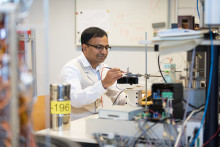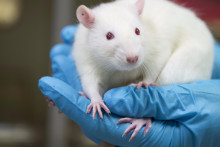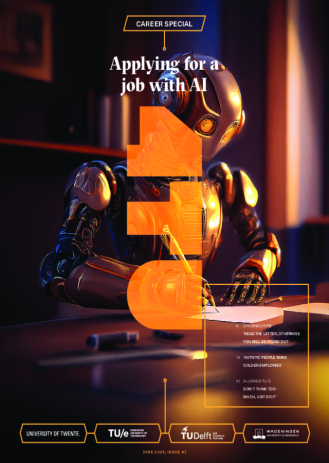Cryogenics refers to production and behaviour of materials at very low temperatures. In his lab at the UT’s Faculty of Science and Technology (TNW), Srinivas Vanapalli works at temperatures of −150 °C and below. If he wanted to work on superconducting electronics, he’d need to crank up the cooling even more and work at temperatures close to absolute zero. What is it all for, though? ‘If you look at Nobel Prizes for physics, quite a lot of them would not be possible without cryogenic expertise. In that sense, cryogenics is often underrated,’ says Vanapalli. ‘Yet, if you want to go to space, you need it. If you have a frozen pizza in your fridge, it has undergone cryogenic treatment. Oxygen tanks in hospitals wouldn’t exist without it.’
‘Cryogenics is often underrated’
Properties of materials are very different at such low temperatures. ‘That is why we do academic research. We study microscale heat transfer at low temperatures in hopes that we can provide empirical data which engineers can use to optimize existing applications or to come up with new ones,’ summarizes the UT scientist. ‘We could contribute, for example, to food processing, pharmaceuticals and medical applications.’
Destroying tumor cells
One of the challenges Vanapalli is tackling together with the University of Nijmegen is a treatment of tumor cells. ‘Cryogenics is already used for sample preservation of tumor cells. However, if you cool the cells fast enough, you can destroy them.’ Which could open up doors to a new cancer treatment. ‘The method is being tested, but it needs to be improved. Right now, a needle is applied to the tumor. It produces high pressure gas, which expands and produces cold, until eventually an “ice ball” is formed. Once the temperature reaches -40°C, the cells are destroyed. We need to understand the cryogenic processes that happen during this procedure, so that we know exactly where and when it is -40°C and not kill any healthy cells. Furthermore, we’d like to increase the cooling capacity of the needle, so that we can progress through the tumor much faster. We have an idea on how to achieve this. We will be developing a needle that has the same volume but a bigger cooling capacity.’
'If you cool the cells fast enough, you can destroy them'
Vanapalli has already contributed to the healthcare industry with another medical application. He has developed a so called ‘snap freezer’, an achievement for which he also received the George T. Mulholland Memorial Award for Excellence in Cryogenic Engineering in 2019. As the name suggests, the snap freezer is able to quickly cool human tissue, which can therefore be immediately preserved and diagnosed. ‘Right now, if a surgeon takes a tumor sample during an operation, the sample needs to be transported and cooled in a different room, because liquid nitrogen is used – and that cannot be in the operating room. The snap freezer can be in the room, however. It is compact and doesn’t use liquid nitrogen, while freezing vials even faster than in liquid nitrogen - down to minus 173 degrees Celsius within 10 seconds. This allows the surgeon to diagnose the tumor and understand what causes the cancer. This is a necessary step toward personalized molecular medicine. The medical center of the Free University in Amsterdam is currently testing the device.’

Freezing tissue in time
Freezing and preserving human tissue is therefore possible. Could all the futuristic films be true then? Could we, one day soon, freeze human beings and bring them back to life later on? This idea has some (but not a lot of) merit, explains Vanapalli. ‘As temperature decreases, your bodily processes slow down. The metabolism slows down, you need to consume less calories and so on. Some scientists are exploring if this process could be used for astronauts who’d travel to Mars, for instance.’ However, when it comes to actual freezing of a human body, the story becomes more complicated. ‘If you go to -40°C, you can create an amorphous form and freeze the tissue in time – and theoretically bring it back to life. Biologists have shown that this is possible with single cells, on a very small scale. The challenge is to scale it up and I doubt it’s possible for an entire human being.’
‘Anyway, freezing humans is certainly not what we do here at the University of Twente,’ adds Vanapalli. The researcher’s goals are a bit more realistic. ‘I’m trying to set up a Center of Excellence in Cryogenic Applications right here at the UT. After all, we are the only group in the Netherlands dedicated to cryogenic engineering. We have a lot of expertise here and there are many challenges we could tackle.’ Besides having the motivation to improve the world, the scientist finds his work simply enjoyable. ‘I’ve always been fascinated by cold. Heating something is easy, but cooling is very difficult. The excitement I felt when I first managed to reach really low temperatures was amazing. Making cold is fun. It’s like a little playground.’







